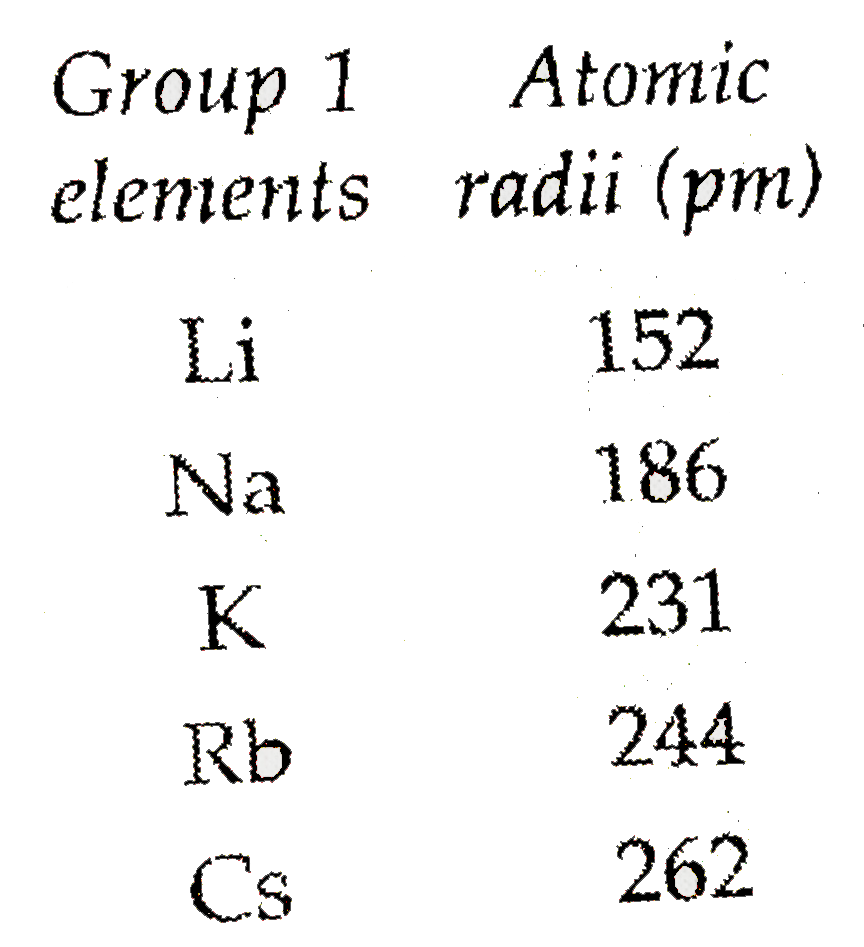The atomic radii of group 1 elemetns of the periodic table are as follows:
and .
(a) Arrange these element in the increasing order of their atomic radii in a vertical column (keeping the element with the smallest atomic radius at the top).
(b) Which elements have the smallest and largest atoms?
(c) From this data, infer how the size (or atomic radius) of elements vary as we go doen in the group
(a) In this problem, the smallest atoic radius 152pm is of so should be placed at the top of the group (as shown in the table alongside). This is followed by and in the downward direction.
(b) The element (Lithium) has the smallest atom (atomic radius 152 pm) whereas the element (Cesium) has the largest atom (atom radius 262 pm).
(c) From this arrangement of elements we conclude that the atom size (or atomic radius) of elements increases on going down in a group.

Topper's Solved these Questions
- PERIODIC CLASSIFICATION OF ELEMENTSBook:LAKHMIR SINGH & MANJIT KAURChapter:PERIODIC CLASSIFICATION OF ELEMENTSExercise:Exercise
Explore 215 Videos
- PERIODIC CLASSIFICATION OF ELEMENTSBook:LAKHMIR SINGH & MANJIT KAURChapter:PERIODIC CLASSIFICATION OF ELEMENTSExercise:SHORT ANSWER TYPE
Explore 8 Videos
- METALS AND NON-METALSBook:LAKHMIR SINGH & MANJIT KAURChapter:METALS AND NON-METALSExercise:Short Answer Type Qustions
Explore 1 Video
- TEST PAPER 1Book:LAKHMIR SINGH & MANJIT KAURChapter:TEST PAPER 1Exercise:Section B
Explore 4 Videos
Similar Questions
Knowledge Check
The atomic radii of transition elements in a period are.
Asmaller than those of s-block as well as p-block elements.Blarger than those of s-block as well as p-block elementsCsmaller than those of s-block but larger than those of p-block elementDlarger than those of s-block but smaller than those of p-block elements
Arrange the given elements in increasing order of their atomic radii? Li, Be, F and N
View SolutionArrange the following elements in increasing order of their atomic radii.
Li, Be, F, N
View SolutionArrange the following elements in increasing order of their atomic radii.
Cl, At, Br I
View SolutionArrange the following elements in increasing order of their atomic radii :
CI,At,Br,I
View SolutionThe atomic radii of the elements of second period are given below:

(a) Arrange these elements in the decreasing order of their atomic radii (Keeping the element with the largest atomic radius first).
(b) Are the elements now arranged in the pattern of a period in the periodic table?
(c) Which elements have the largest and the smallest atoms?
(d) From this data, infer how the atomic size (or atomic radius) of the elements changes as you go from left to right in a period?
View SolutionArrangement the following elements in increasing order of their atomic radii
(a) Li, Be, F, N
(b) Cl, At, Br, I
View SolutionArrange the above elements vertically downwards in an increasing order of atomic radii.

View Solution

